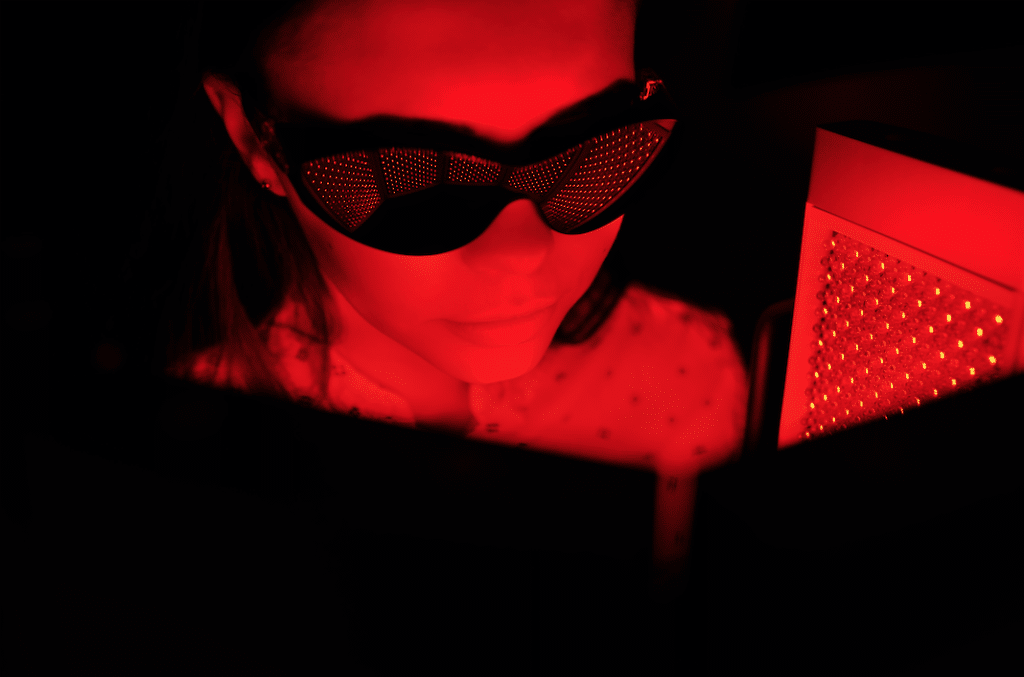
Sometimes, it’s hard to get excited about a product, treatment or therapy when it’s well-paid celebrities and influencers telling us about the benefits.
If you’re not careful, you can find yourself feeling this way about red light therapy. It might be great for supermodels and UFC fighters – but what about normal people like you and I?
The Efficacy of Red Light Therapy
As with any scientific claim, it’s useful to start looking for proof that near-infrared light treatment works in reputable labs and academic journals.
One of the most significant studies to date was carried out in 2014.1 136 volunteers took part in a large trial that would test the anti-aging properties of light treatments. After a number of red light sessions, a ‘blind’ clinical evaluation took place.
Not only did this final medical assessment decide there was “significant improvement” in the test group, the treated subjects experienced “significantly improved skin complexion and skin feeling”. It’s rare that a trial offers such definitive evidence that a treatment has clearly positive effects – but when red light was put to the test, that’s exactly what was proved.
What’s involved?
So red light’s passed the test in clinical trials – but what’s actually involved when you use a light therapy device?
In real terms, red light boosts how effectively the cells in your body work. As well as allowing us to see what’s around us, light is an energy – and certain wavelengths provide the exact kind of energy our cells require to perform a huge number of functions within our bodies.
Unlike pharmaceutical options, red light treatments don’t just solve one problem. Instead, they actually aid our cells in tackling an enormous range of issues – from increasing collagen production to help smooth out fine lines, right through to reducing the appearance of acne scars, rosacea, and other skin conditions.
The best part?
Near-infrared light therapy treatments are completely non-invasive. As such, there’s no downtime and no need for recovery before you get back to real life – just an extremely effective way of enhancing your skincare regimen.
Of course, the benefits of red light therapy go well beyond just tackling skin issues. If you’d like to dig a little deeper into some of the other ways the treatment can be used, I’ve created a blog post that explores many more beneficial uses.
What to Expect After LED Light Therapy
Aside from the fact that Botox, peels, and fillers all require medical-grade products to be injected into, or applied onto your face, there’s also some downtime afterwards. In most cases, you won’t be able to exercise for a number of hours – and in others, you can’t even lie down in case the products move and become ineffective.
So, what happens after a light therapy session?
The good news is; there’s zero recovery time. Want to jump straight into the pool? No problem. Heading straight to bed? Great! You’ll probably sleep even better than usual.
Part of the reason red light therapy is becoming so popular with dermatologists is because of the non-invasive nature of the treatment. Since there are no needles or foreign substances being applied or injected, there are none of the usual side-effects that go hand-in-hand with these kinds of treatments.
How long do red light treatments last?
Although I’d love to tell you that a single treatment will rejuvenate your skin cells for life – red light therapy doesn’t work like that.
You’ll start to feel benefits after your first session, and you’ll unquestionably start to see results in the mirror even before you’ve achieved the recommended number of treatments – but the results aren’t permanent.
We already know that our bodies need the right food and adequate hydration regularly if we want to maintain peak health – and the same is true with light and the health of our cells.
To understand why, it’s useful to explore what right light does to your body. To do so, you need to think on a microscopic level.
Natural light is made up of infrared, visible, and ultraviolet light. Different types of light have different wavelengths – and it’s the energy that comes from red light that our cells can use as fuel to perform their nearly countless functions.
Boosting ATP energy
You might not have previously heard of adenosine triphosphate (ATP) – but it’s the kind of ‘fuel’ your cells rely on to drive an almost limitless range of processes. From the collagen production needed to help wounds heal – to the communication that occurs between cells to coordinate their functions, ATP is there, providing the energy needed.
ATP is produced by a part of the cell called the mitochondria. It’s useful to think of the mitochondria as a kind of miniature power plant; using the nutrients available to create the ATP the cell around it needs. While the mitochondria will create ATP from energy from the food we eat, it’s especially responsive to the kind of energy that comes from red light.
When red light’s delivered at the necessary wavelength to nourish mitochondria, they work more effectively – and, as a result, the cells around them also work more effectively – both in carrying out that task at hand, and coordinating surrounding cells to do the same.
This process is precisely why red light therapy’s benefits are so numerous. Where pharmaceutical medicines target specific functions or problems in your body, red LED light instead causes your cells to be more effective; so your body naturally repairs and rejuvenates better than ever before. Strictly speaking, infrared light therapy doesn’t fight the signs of aging – it simply causes your body to do a better job itself!
Maintenance sessions
You can probably see now why red light doesn’t provide a one-off, never-ending solution to better and healthier skin. The cells that it helps to boost need energy on an on-going basis, so while you’ll see results quickly, you’ll need to keep nourishing your cells as maintenance.
Depending on the skin issues you’re tackling, you may find maintenance sessions every few months suffice. Then again, you might need sessions slightly more regularly. You won’t have to guess though – as your therapy provider will be experienced enough to understand your specific needs.
Of course, there is an alternative if you prefer not to rely on a salon or therapy provider.
Increasingly, people are choosing to buy their own infrared light therapy devices for home use. Since possible side-effects are extremely limited and the treatment is non-invasive, it’s perfectly safe to indulge in some treatment time without leaving the house. In fact, in many cases, it makes financial sense to do so. Many providers charge over $100 per session – so your own system would quickly pay for itself.
If you’re interested in exploring some home devices, I’ve reviewed a number of lamps – and listed prices and few pros and cons of each.
Give it a Go

Countless studies now prove that red light therapy can be used to boost the production of collagen – the key component when it comes to improving the condition of your skin. Collagen is vitally important for skin health – in fact, it’s used to help treat people who have been the victim of burns, and it helps to reduce scarring while speeding up the healing process.
What could boosted collagen production and increased cell rejuvenation offer you?
Would you like to get rid of wrinkles and fine lines? Aiming to tackle stubborn cellulite? Perhaps you’re hoping to reduce stretch marks or improve your skin tone? Time and time again, low-level light therapy (LLLT) has delivered results that are as good as, or better than medical interventions. What’s more, light therapy comes with virtually no side effects – and you can use it across your full body safely.
Now you’ve seen the effect that just a small number of sessions can have on a host of different conditions; the next step is to try red light therapy yourself!
Will you find a practitioner or red light bed near you? Or will you pick one of the fantastic devices that you can use at home? The choice is yours – but don’t forget to take some ‘before’ pictures so you can look back and appreciate just how effective your first red light experience has been!
If you’re still curious about red light treatments, you might want to explore the blog a little more. Amongst a wealth of helpful and informative articles, you’ll find information on the use of red light to reduce inflammation, whether red light can tighten loose skin, and more detail on how red light can help to reduce cellulite.
References[+]
| ↑1 |
Wunsch, A, & Matsuschka, K, (2014). A Controlled Trial to Determine the Efficacy of Red and Near-Infrared Light Treatment in Patient Satisfaction, Reduction of Fine Lines, Wrinkles, Skin Roughness, and Intradermal Collagen Density Increase. Photomed Laser Surg. 2014. |
|---|




